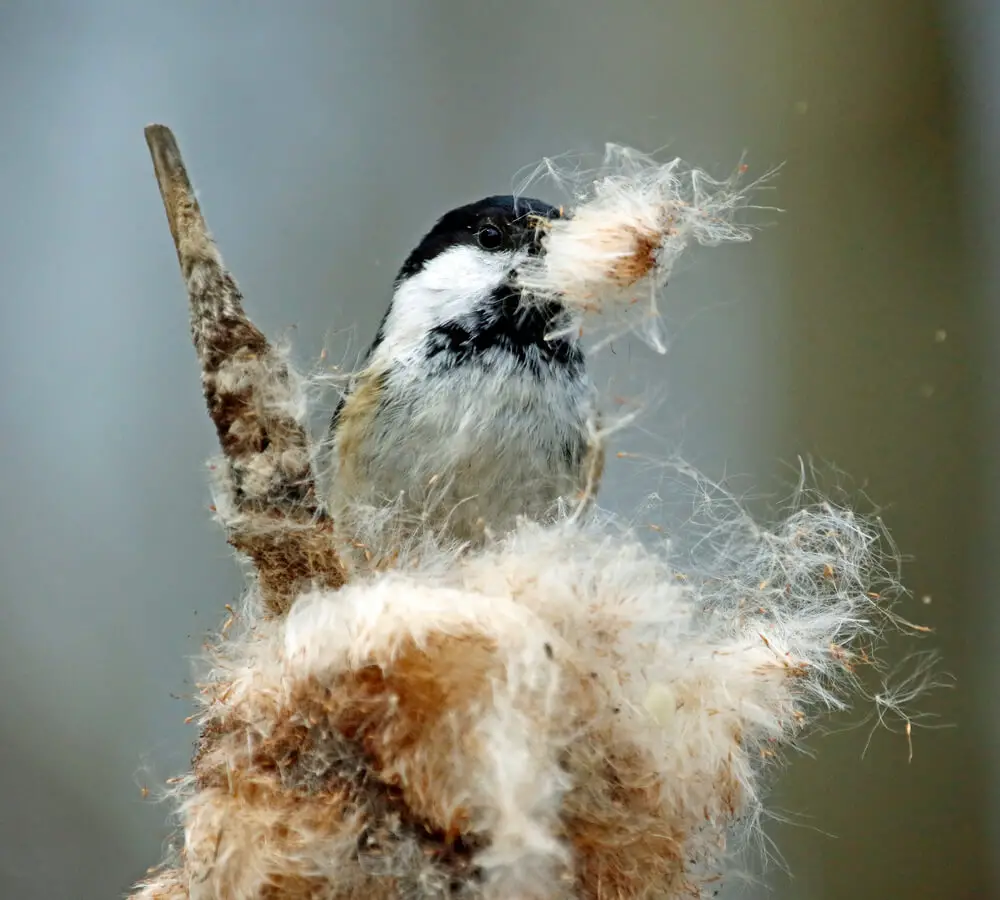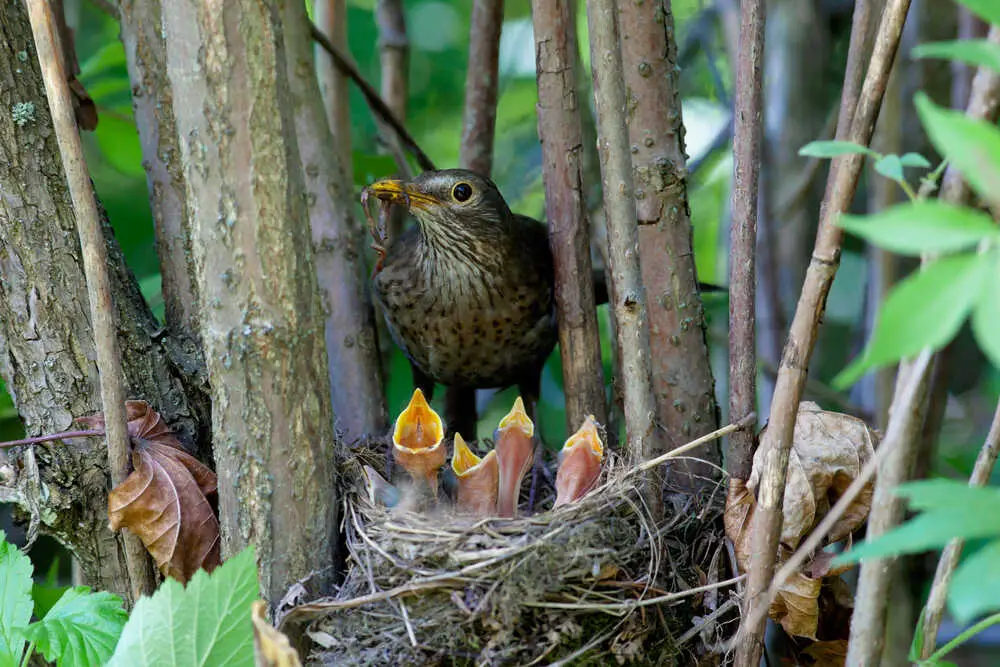Don’t you love seeing the tiny crocuses and daffodils poking their heads through the soil when you’re out walking? It is one of the first signs that spring is springing and the weather should soon warm up.
It is the time of year that I notice the birds reappearing from their winter hideouts and busying themselves.
If you’re unsure whether your garden birds are foraging for food or looking for building materials in early spring, read on to discover when birds start nesting.
You might be surprised to discover the early-starters and those birds that nest all year round.
Table of Contents
When do Birds Start Nesting?
You might think that nesting refers to the act of building the structure when it actually refers to when birds start laying eggs.
Typically, nesting season occurs anywhere between February and August, although the busiest period tends to be between March and July.
Several factors define when birds begin nesting, including; the species, the bird’s age, the weather, the time it takes to build the nest, and how long it takes for the chicks to fledge.
Let’s look in more detail…
What is Nesting?
Nesting refers to the season that pairs of birds mate, lay eggs, and raise their young.
Nests are structures to keep eggs and chicks secure against the elements and predators.
They also need to be safe and warm.
Garden birds construct most nests from twigs, moss, and lichen woven tightly to form a robust cup.
Birds use various soft lining materials, including feathers, sheep’s wool, moss, hair, and webs.

Cleverly, they use glue-like spider’s web or clumps of mud to waterproof and bond the nest.
The female typically builds the nest while the male watches on protectively or collects building materials.
This is true of many species, but not all.
Cavity nesting birds also line the pre-formed or excavated hole or a bird box.
The space is robust enough to last until the young are grown and strong enough to fledge the nest.
Nesting Time is Getting Earlier
Back in the 1960s, birds began to nest around a month later than they do now.
The BTO (British Trust for Ornithology) recently undertook a national study. It discovered that many wildlife species, including some garden birds, were preparing to lay their eggs earlier than ever before.
Climate change is the culprit; birds falsely believe that it’s later in the year and begin the mating process.
There are several disadvantages; the plants and insects on which chicks feed are not yet available, resulting in starvation and death of some bird species.
Which Birds are the Earliest Nesters?
The accolade of earliest nester goes to the wood pigeon; however, they also get the award for the birds that build their nest latest in the year.
Confused?
Wood pigeons build nests at any time of year. They use their construction year-round, only abandoning it to flee from predators or if damaged beyond repair.
They lay 1 or 2 eggs at a time and prefer the privacy of secluded woodland.
Should the brood fail, wood pigeons lay more eggs until they have at least one successor per season.
They are very concerned with continuing the bloodline.
Crossbills are so-called due to the unique twist in their beak. They are native to northern England and Scotland, where they inhabit conifer forests.
They begin building their nests in January, sometimes earlier. It enables the birds and their young to take advantage of the plentiful conifer seed stock at the beginning of the year.
While most birds are incubating eggs, crossbills are preparing to fledge. They have unrivalled access to their favourite food. Smart, eh?
Ravens build their nests in February. They are one of the few birds that couple for life, so after the first year, there is no time wasted trying to impress each other, just down to the business of nest building.
It comes as a relief for the male, whose courtship routine is very intricate and tiring.
They nest on coastal cliffs, mountainsides, quarries, and in dense parklands. The nest is made from twigs and moss, and the female typically lays 2-4 blue/green eggs.
Long-tailed tits are small balls of fluff that begin building their nests earlier than most other birds.
Their work starts in early February; each nest is a magnificent honeycomb shape that is a feat of engineering. It is so complex that it takes at least 3-weeks to complete.
They are typically well-camouflaged within gorse or holly bushes, with internal chambers lined with dozens, if not hundreds of feathers.
Although they begin early, long-tailed tits don’t lay eggs until April.

Blackbirds spend much of their time foraging around the ground for earthworms.
They sometimes begin nesting activities in late February; most have started building by the first week in March.
They continue to nest through until late July; it isn’t unusual to see chicks in the nest in August.
Blackbirds will reuse the same nest throughout this time, often having multiple broods. They typically have 2 or 3 clutches of eggs each nesting season; some birds manage a 4th in ideal conditions.
Other early nesting birds include;
- Thrush
- Robin
- Bluetit
- Great Tit
- Coal Tit
Problems Faced by Birds that Start Nesting Early
Spring is the most obvious time of year for new life to appear.
The weather warms up, insects and bugs are available in abundance, and plant life starts to flourish.
Climate Change
The biggest impact on early nesting birds is that of climate change.
Birds’ body clocks trigger them into thinking nesting season has come early; nest construction begins days or weeks prematurely.
The insects on which the chicks feed haven’t yet emerged.
It has a catastrophic effect on the birds that don’t adapt; the young birds become emaciated and die.
Some bird species might attempt another brood if the first failed. The second clutch of eggs has greater chances of survival; food is in greater abundance, and the weather should be warmer.
Some birds adapt and take advantage of being the first to nest.
There is less competition for food; if a bird finds a source, it can keep it all for its family.
Tawny oils need to nest early in the season. They usually have chicks in the nest before March is out.
Parent birds hunt for prey, swooping down on small creatures to feed their young. Grass and vegetation grow as spring heads into summer. It is easier for the owl to spot prey when the grass is short – there are fewer places to hide.
Late Nesting Birds
Not all birds’ nesting activity occurs in the spring.
Sometimes during late summer, when most chicks have grown and become independent, you might see freshly-fledged birds hopping around.
It is often down to good conditions enabling birds to attempt second, third, or fourth broods.
Some birds wait until later in the year to attempt their first brood.
Greenfinches and chaffinches are in no rush to nest.
They are seed-eating birds; dandelion, thistle, and burdock that they favour are in abundance throughout the summer and beyond.
Wood pigeons nest late in the year; they also nest early! They build their nests year-round and at random times.
Robins and blackbirds sometimes attempt a second brood late into summer, especially if their early one failed for some reason.
A friend of mine spotted a blackbird nest in the roof space of a heated outbuilding in mid-October.
He was mindful to leave plenty of live mealworms on the surrounding ground, as their favoured earthworms are harder to come by as the weather gets colder.
Many bird species will still nurture their young well into the summer if attempting consecutive broods.
The biggest downfall to starting nesting later in the year is the competition for food.
Conclusion
Garden birds start nesting from February to late August, with the busiest activity in March to July. Thin spring-ish and go a couple of months either side!
It is a good idea to leave bird boxes up for an extra month or two after you think any nesting birds have flown.
I suggest waiting until October, at the least, before taking them down to repair and clean.
And feed our garden birds year-round, if possible. We are never too sure if they’re struggling to feed hungry chicks and can use a helping hand, whatever the season.
